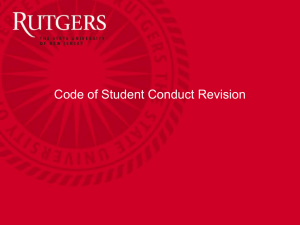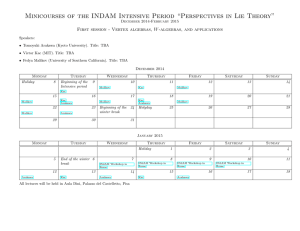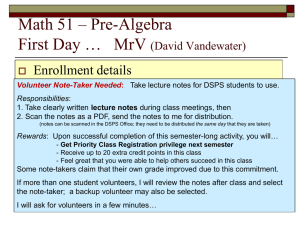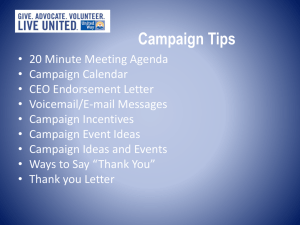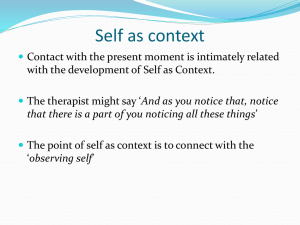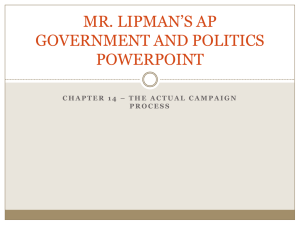Pressure groups - Hodder Education
advertisement
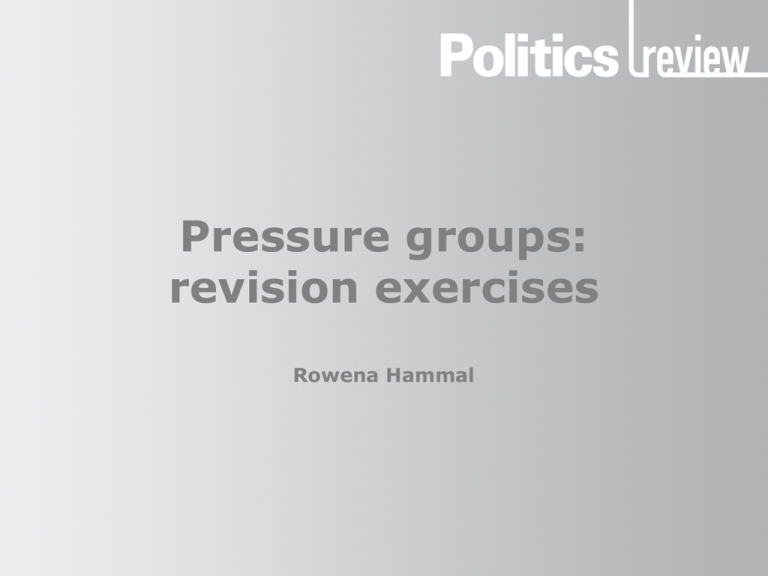
Pressure groups: revision exercises Rowena Hammal Pressure groups: revision exercises How to use these revision exercises • These exercises will be most useful as part of your preparation for the exam if you attempt them once you have revised your class notes. • Go through this PowerPoint and try to answer each question from memory. • Check your understanding against the answers. Your examples may differ from those given. • All the information in this exercise is essential, so you need to learn it. Note: This exercise covers important areas of the topic but is not intended to be an exhaustive guide to everything you need to know. Be sure to work through the syllabus for your exam board to check that you have revised everything. Pressure groups: revision exercises Definition Answer the following questions: 1. Define a pressure group. 2. Define a social movement. Pressure groups: revision exercises Answers: definition 1. Define a pressure group. A pressure group is an organisation which campaigns to influence politics. For example, the NSPCC campaigns to encourage the government and parliament to introduce policies and pass laws that support the protection of children. Pressure groups differ from political parties because they only seek to influence, whereas a political party aims to wield political power. Pressure groups can be very small, such as a local conservation group with only a handful of members, or their membership may be huge. The Unite union is the largest trade union in the UK, with 1.4 million members. Continued on the next slide… Pressure groups: revision exercises 2. Define a social movement. A social movement is a long-term campaign for the improvement of some area of society. In the first part of the twentieth century the labour movement tried to improve conditions for the industrial working class. A great number of new social movements developed from the 1960s, and focused primarily on social issues rather than economic concerns. These include the feminist movement, the protection of the environment, and gay rights. The anti-nuclear campaign was also very popular during the Cold War, particularly from the 1960s to the 1980s. A social movement is generally less organised than a pressure group, and may include many types of pressure groups. For example, the gay rights movement includes pressure groups Stonewall and OutRage!, and internet campaign groups such as All Out. It also includes other groups such as the National Union of Teachers (NUT) which, while their main focus is education rather than gay rights, does promote gay rights by supporting LGBT teachers. Pressure groups: revision exercises Classification Answer the following questions: 1. Define the following terms: • Sectional/interest groups • • Cause groups Insider groups • Outsider groups 2. Give at least one example for each type of group 3. What are the limitations of classifying pressure groups as insider/outsider or cause/sectional? Pressure groups: revision exercises Answers: classification 1. Define the following terms: Sectional/interest groups These defend the interests of a particular group or section of society. All trade unions are interest groups as they protect the interests of their members. The British Medical Association (BMA) fights for the interests of doctors, and makes campaigns on their behalf in relation to pay and working conditions. Cause groups These promote a specific cause. They are inclusive, as members need not have a personal connection to that cause in order to join, unlike interest groups. Anyone can join the housing and homelessness charity, Shelter, and most of their members are not homeless. Cause groups encourage people to join for altruistic reasons, and often aim to build mass memberships which demonstrate the level of public support for their cause. Continued on the next slide… Pressure groups: revision exercises Insider groups These are groups that are consulted by government and therefore have insider status. Insider groups need to be law-abiding and maintain a good public image in order to retain the trust of the government. The BMA is a good example of an insider group as it is consulted as a matter of course on health-related matters. Similarly, the Confederation of British Industry (CBI) is consulted on issues that affect business. Outsider groups These groups are not consulted by the government so instead try to influence them from the outside. Some outsider groups may be working towards insider status, whereas others are ideologically opposed to the government and are happy to remain outsiders. For example, the Animal Liberation Front (ALF) pursues its aims using extreme tactics which are incompatible with insider status. 2. Give at least one example for each type of group (see examples listed above and on the previous slide) Continued on the next slide… Pressure groups: revision exercises 3. What are the limitations of classifying pressure groups as cause/sectional or insider/outsider? •Sectional groups frequently work for a cause as well, so they are not purely selfinterested. For example, the BMA is a trade union for doctors, but it is also a professional association which aims to promote public health issues and lead debates on new treatments and types of healthcare. •Insider groups can become outsider groups, and vice versa. Some move back and forth depending on which party is in government. Trade unions have traditionally been consulted more by Labour governments as they share Labour’s ideology and contribute a large proportion of Labour Party funding. •Some pressure groups may only be consulted occasionally by government. These are known as peripheral insiders because they have such limited access. •Even if a group is consulted by government regularly, it may have limited influence if they fundamentally disagree. The NUT has criticised Michael Gove’s education reforms despite being consulted as part of the reform process. Pressure groups: revision exercises Pressure group methods Answer the following questions: 1. Complete the table with examples of different types of methods. Conventional methods Direct action Petitions Legal stunts, e.g. Surfers Against Sewage have attracted media attention by posing for pictures wearing gas masks, and sitting on toilets on the beach. • e.g. the Gurkha Justice Campaign petitions were signed by people across the country • e.g. the Snowdrop Campaign petition, which attracted 750,000 signatures in 6 weeks 2. Why do groups use direct action? Pressure groups: revision exercises Answers: pressure group methods 1. Complete the table with examples of different types of methods. Conventional methods Direct action Letter writing campaigns, e.g. Blockading access/occupying areas Burma Campaign UK organised a (sometimes illegal): letter-writing campaign to ask Foreign • Secretary William Hague to put tax caused fuel shortages in 2000. Governments have since been reluctant to raise fuel duty pressure on the Burmese government to release its political prisoners. blockades of oil refineries in protest at high fuel • Plane Stupid occupied Stansted Airport runway Marches, e.g. the Stop the War march in 2008 in protest against plans to build a against invading Iraq in 2003 in second runway London. Some 2 million people marched in an unsuccessful attempt to prevent the government from going to war. • environmental pressure groups such as No Dash for Gas have blockaded oil drilling sites (such as Balcombe in 2013) in protest against fracking Continued on the next slide… Pressure groups: revision exercises Conventional methods Direct action Consultation, e.g. the BMA was consulted by the government when it was developing the Health and Social Care Act 2012, and was able to influence the final bill. Violent illegal activity, e.g. student marches against tuition fees in London in November 2010 turned violent. Windows were smashed, Prince Charles’s motorcade was attacked, and over 50 people were injured. Lobbying, e.g. the Gurkha campaign lobbied MPs to put pressure on the government to give some Gurkha veterans the right to remain in the UK. Illegal threats and intimidation, e.g. animal rights campaigners from the Animal Liberation Front (ALF) were convicted in 2008 of threatening companies connected to Huntington Life Sciences animal research laboratory. Collecting information to further their cause, e.g. the BMA has collated research by doctors and scientists to support minimum alcohol pricing. The professional expertise of its members ensures that its findings are taken seriously by the media Continued on the next slide… Pressure groups: revision exercises Conventional methods Direct action Legal challenges: •the Child Poverty Action Group (CPAG) has made numerous legal challenges to the coalition government’s welfare changes •in 2012 the pressure group Fair Energy made a complaint to the European Commission about government nuclear subsidies, which it claimed was in breach of EU law Continued on the next slide… Pressure groups: revision exercises 2. Why do groups use direct action? There are many reasons for this, some of which do not apply to all groups: • achieves instant media attention and cheap publicity • allows new groups to make a name for themselves • disenchantment with traditional campaigning methods, which are seen as ineffective • frustration with the political status quo and a desire to force a radical change Pressure groups: revision exercises Pressure group access points Answer the following question: 1. What access points can pressure groups use to access the political system? Pressure groups: revision exercises Answer: pressure group access points 1. What access points can pressure groups use to access the political system? • local government • devolved governments and parliaments or assemblies of Scotland, Wales and Northern Ireland • UK government • UK parliament (via MPs) • UK judiciary (via a legal challenge) • European Commission • European Parliament (via MEPs) • Council of the European Union • European Court of Justice (via a legal challenge) Pressure groups: revision exercises Pressure group success Answer the following question: 1. What factors make pressure groups successful? Pressure groups: revision exercises Answer: pressure group success 1. What factors make pressure groups successful? •Achievability of aims — are they limited and readily achievable? For example, the Snowdrop Campaign was set up after the Dunblane massacre of 1996 and aimed to ban private ownership of handguns in the UK. This was straightforward to achieve, via an Act of Parliament passed in 1997. •Public support — e.g. the Snowdrop Campaign had huge public support, which ensured that MPs and the government were keen to tackle handgun ownership. •Membership — large (e.g. RSPB 1.2 m members) or highly regarded (e.g. BMA). •Celebrity endorsement, e.g. Joanna Lumley and the Gurkha Justice Campaign. •Methods — pressure groups need to target the appropriate access points in ways that promote their cause. Continued on the next slide… Pressure groups: revision exercises • Money — to fund offices, equipment, staff etc. For example, the CBI has offices across the UK and internationally, in order to lobby government effectively and promote British business. • Insider status — is helpful in achieving success as it ensures the government hears the pressure group’s views, e.g. BMA and the 2007 smoking ban. • Media support — e.g. the media supported the Snowdrop Campaign. Note: media support is not the same as media attention. The ALF has gained considerable media attention, but is widely condemned by the media for its extreme tactics. To revise this topic in greater detail, use the article ‘Pressure groups: what makes them successful?’ by Paul Fairclough, POLITICS REVIEW, volume 23, number 1, pp. 2-5 Pressure groups: revision exercises Are pressure groups good for democracy? Make bullet points to explain the different sides to this argument. Pressure groups: revision exercises Answer: are pressure groups good for democracy? There are several opposing sides to this argument: 1. The pluralist view •Pressure groups allow different people to have their views heard by government and are an essential part of democracy. •Pressure groups provide the government with information and statistics that it might otherwise not discover. •Pressure groups allow people to focus on one issue which really concerns them (e.g. the environment) but which might not be their prime concern in an election. It is important that government is held to account for the things that do not win elections, but which still matter. •Pressure groups allow people to participate in democracy at any time, rather than just during an election campaign every 5 years. Continued on the next slide… Pressure groups: revision exercises 2. The elitist view •Pressure groups are undemocratic as they allow those with the loudest voice to be heard most. The rich, the educated, the articulate and the well-connected are far more able to form influential pressure groups than the poor and disadvantaged. •The leaders of pressure groups are often middle class, so they do not provide a good forum for the voices of the working class. •Pressure groups often suffer from poor internal democracy, so they cannot be said to truly represent the views of their members. Decisions are often made by the leadership and handed down to the grass roots with little or no consultation. Unions are legally obliged to ballot their members before strike action, but low turnout (in 2011 only 40% of NUT members turned out in a strike ballot) suggests that the grass roots lack commitment to their cause. Continued on the next slide… Pressure groups: revision exercises 3. The New Right view This viewpoint is associated with Thatcher’s Conservative government, which was keen to reduce the power of trade unions. •Douglas Hurd referred to pressure groups as ‘serpents that strangle efficient government’. •Pressure groups interfere with democracy by hampering elected governments. •Strikes and direct action are an attempt to undermine the democratic state. •Pressure groups focus on one particular issue to the exclusion of everything else. They prevent politicians from delivering ‘joined-up’ government. •Pressure groups are unaccountable to the electorate. •Pressure groups sometimes get their information wrong, e.g. in 1995 Greenpeace apologised for releasing inaccurate information about the Brent Spar.



